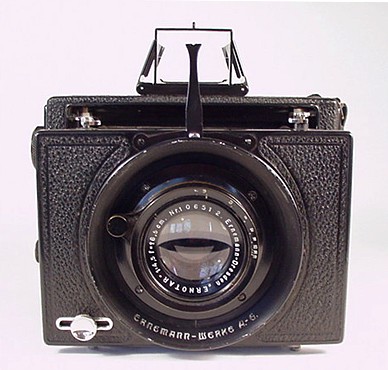
Ernemann Klapp Camera

Pictured above is a late model of the Ernemann Klapp series of strut-folding plate cameras. The Klapp line, launched in 1901 underwent a few generations of improvements, culminating in this design which was state-of-the-art in its day. The camera's serial number dates this example to 1922. The late series was manufactured from 1920 to 1926. Ernemann of Dresden Germany operated from 1889 until 1926, when it merged with Contessa-Nettel, Goerz and Ica to form Zeiss Ikon.
Klapp cameras were available in a variety of plate sizes. This is a 10 x 15 cm model. Measured in inches, the image size is slightly smaller than 4 by 6. Held in the hand, the camera feels very solid and a bit heavy. On my postage scale the Klapp weighs-in at 4 3/4 pounds. Ernemann produced many well-engineered high-quality cameras. This is certainly one of them.
Ernemann Klapp cameras have an eye-level Newton viewfinder consisting of a rectangular negative lens and sighting post. The viewing lens is etched with a cross-hair. In use, position your eye behind the lens in such a way that the center of the cross-hair aligns with the groove at the tip of the sighting post. Doing this squares the finder with the scene for accurate framing. On late models the viewfinder lens is protected by a metal cover.
To set focus, the distance can be measured or guessed at and set on the lens focusing scale. Or alternatively, the ground glass back can be used to precisely judge focus, depth of field and composition. When using the ground glass screen the camera needs to be mounted on a tripod. The Newton finder can be used for hand-held exposures.
The chrome knob seen on the camera front is used to lock the rising and shifting lens panel in place. Rise and shift movements allow limited perspective control. Rise and shift are the only perspective control adjustments provided by the Klapp.
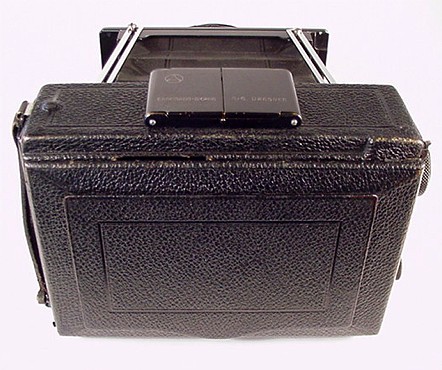
To load a plate holder, first slide the ground glass back off the camera body. Then slide the holder into place. The requirement to remove the focusing panel in order to load a plate holder was common to a variety of cameras. This meant that the photographer needed to find a clean, safe location to store the fragile back between shots. The back would probably be set in a carrying case that also stored the plate holders. An alternative and popular design was for the focusing panel to be attached to the camera body by springs. Loading a plate only involved inserting the holder under the panel. There was no need to remove the back and set it down. This difference may seem trivial but it is significant to a working photographer.
The ground glass screen is protected by a leather-covered panel that hinges up for viewing. The panel helps to shield extraneous light, making for a brighter image on the ground glass.
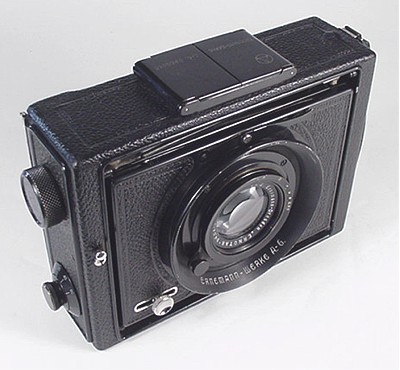
Collapsed, the camera is 6 inches high, 8 3/4 inches wide, and 3 1/4 inches deep. This is a neat, compact and sturdy package for a large format camera. It is carried comfortably by the sturdy leather carrying strap. The top-mounted viewfinder is well protected.
The camera is easily and quickly opened by grasping that giant bell around the lens and pulling out. The four struts snap smartly into place at the edges of the lens panel. The lens panel is rock solid.
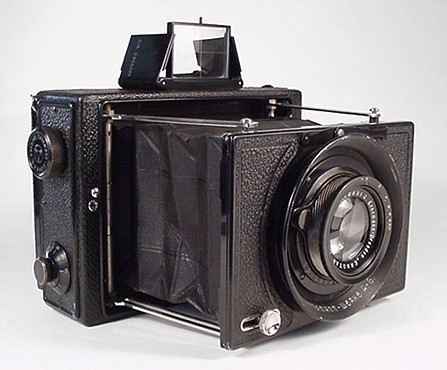
Notice the struts that support the lens panel. Strut cameras suspend the lens panel outward on thin lightweight arms. This design eliminates the awkwardness and extra weight of a baseboard. Many excellent, rigid strut designs have been created by a variety of manufacturers.
Also notice the exposed threads of the lens focusing mechanism. The threads are large enough that it would take a lot of dirt to fowl the focus mount, but in dusty environments, and over time dirt would accumulate and cause problems. It makes sense to store or carry the camera with the focus set to infinity to protect the threads.
The non-interchangeable lens is an uncoated 16.5cm f/4.5 Ernotar with stops to f/50. Close focus is 1.5 meters.
The large knob on the side, near the top, is the focal plane shutter winding knob. The knob below this is the shutter slit-width control. On the camera front edge, midway between the knobs, are two small round silvery objects. These are the shutter release button and cable release socket.

Notice the deep concave curves of the viewfinder lens, and the etched cross-hair.
Inside the viewfinder frame is a shutter speed table. Operation of a focal plane shutter in the 1920s was not as simple as it is today. Modern focal plane shutter cameras have a single control, with speeds directly marked. Older cameras did not. In fact, Ernemann introduced a simplified 2-step operation with the late model Klapp cameras, an improvement over the earlier 3-step procedure. Shutter times on this model were regulated by setting both the slit-width control and shutter tension control. Different combinations of curtain slit-width and tension produced the full range of possible shutter times. The different combinations of settings are laid out in this speed table. As an example, to shoot at 1/200 second, one would set the tension control to 12 and the slit-width control knob to 10.
The Klapp's focal plane shutter produces speeds of 1/10 to 1/1000 second, and time and bulb.
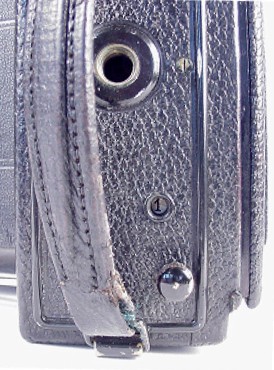
The small round knob is the shutter tension control. The window above this knob indicates that tension 1 has been set. Above the tension window can be seen a tripod socket, hiding beneath a heavy leather carrying strap. How can a tripod be mounted to this socket with the strap in the way?
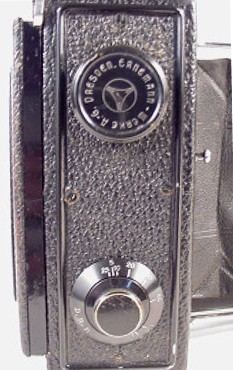
This view shows the shutter wind knob on top, and slit-width control knob, below. The slit-width knob does just that - it varies the focal plane shutter's curtain width to produce different exposure times for a given shutter tension.

Ahh. Notice a round raised area in the top leather covering. Push this to unhook the carrying strap. Now the tripod socket is accessible.
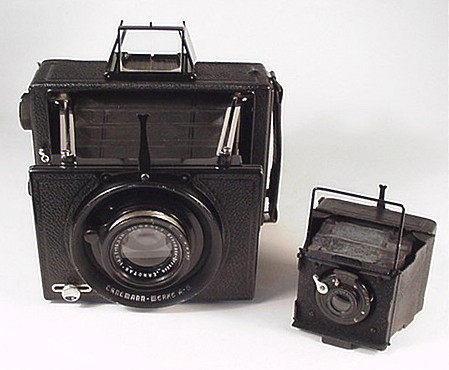
For size comparison, here is a photograph of two Ernemann strut folding cameras. On the left is the 10 x 15 cm Klapp, and on the right is the Mignon 4.5 x 6 cm model.

|
Page created January 21, 2002;
updated December 20, 2020 |